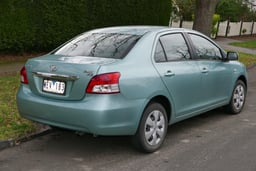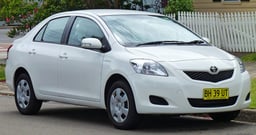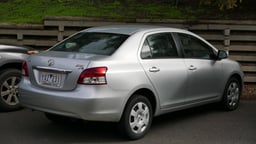Toyota Belta
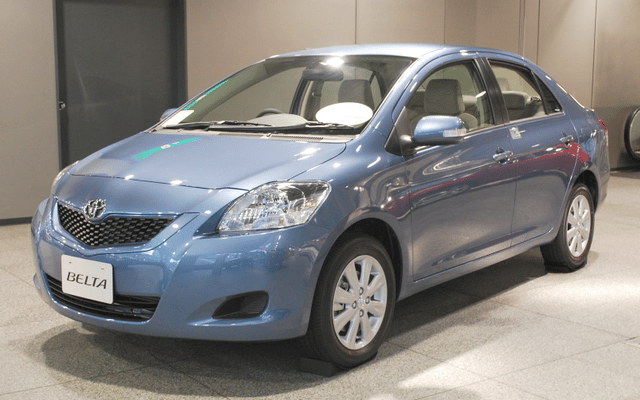
Toyota Belta

| Toyota Belta (XP90) | |
|---|---|
| Overview | |
| Manufacturer | Toyota |
| Also called | Toyota Yaris Toyota Vios Toyota Limo (Indonesian taxi version) |
| Production | November 2005[1] – June 2012 (Japan) 2012–2016 (extended production) |
| Model years | 2006–2016 |
| Assembly | China: Tianjin (TFTM)[2] Indonesia: Karawang Japan: Kanegasaki, Iwate (KAW) Malaysia: Shah Alam, Selangor Philippines: Santa Rosa, Laguna Thailand: Chachoengsao |
| Designer | Takashi Hagino (2003) |
| Body and chassis | |
| Class | Subcompact car |
| Body style | 4-door sedan |
| Layout | Front-engine, front-wheel-drive |
| Platform | Toyota B platform |
| Related | Toyota Vitz (XP90) |
| Powertrain | |
| Engine | 1.0 L 1KR-FE I3 1.3 L 2NZ-FE I4 1.3 L 2SZ-FE I4 1.5 L 1NZ-FE I4 |
| Transmission | 4-speed automatic 5-speed manual CVT automatic |
| Dimensions | |
| Wheelbase | 2,550 mm (100.4 in) |
| Length | 4,300 mm (169.3 in) |
| Width | 1,695 mm (66.7 in) |
| Height | 1,460 mm (57.5 in) |
| Chronology | |
| Predecessor | Toyota Platz Toyota Vios (XP40) |
| Successor | Toyota Corolla (E160) (Japan) Scion iA/Toyota Yaris iA (North America) Toyota Vios (XP150)/Yaris (Asia/Middle East/Americas/African sedan market, except Japan, Korea, Oceania, South Africa, Hong Kong and Macau) |
The successor to the discontinued Toyota Platz sedan, the Belta has increased in size over the previous generation such that its interior volume is larger than the E120 Corolla. The Belta went on sale in Japan on 28 November 2005 equipped with 1.0- to 1.3-liter engines and is available at Toyota dealership Toyopet Store. Export sales began in 2006, with most markets receiving a 1.5-liter engine as standard fitment.[3]
For most Asian markets (except Japan, Hong Kong and Macau), the Belta is sold as the Vios is built and assembled in the Philippines and Thailand. For the Japanese, American and Middle Eastern markets (except Israel, Morocco, United Kingdom, Korea, Russia and Europe) the Belta is built in Japan.
The XP90 Vitz and Belta share underpinnings with each other including the drivetrain and platform. However, while the Vitz was designed at Toyota's French design studios, the Belta was designed at Toyota's Japanese design studios—design projects for similar cars marketed toward different demographics. While the outgoing Vitz and Platz models look and feel very much alike, the new Vitz hatchback and Belta sedans are more subtly related. No sheetmetal is shared between the two, and although both have a similar centralized dashboard design (Toyota's efforts to standardize the design for all markets, left or right hand drive) there are some cosmetic differences. The Belta is the only subcompact sedan which is designed, built and sold in Japan, and has no direct competitors in the Japanese Domestic Market, as the Vitz's competitors do not offer sedan versions at the time.
| Toyota Belta (XP90) | |
|---|---|
| Overview | |
| Manufacturer | Toyota |
| Also called | Toyota Yaris Toyota Vios Toyota Limo (Indonesian taxi version) |
| Production | November 2005[1] – June 2012 (Japan) 2012–2016 (extended production) |
| Model years | 2006–2016 |
| Assembly | China: Tianjin (TFTM)[2] Indonesia: Karawang Japan: Kanegasaki, Iwate (KAW) Malaysia: Shah Alam, Selangor Philippines: Santa Rosa, Laguna Thailand: Chachoengsao |
| Designer | Takashi Hagino (2003) |
| Body and chassis | |
| Class | Subcompact car |
| Body style | 4-door sedan |
| Layout | Front-engine, front-wheel-drive |
| Platform | Toyota B platform |
| Related | Toyota Vitz (XP90) |
| Powertrain | |
| Engine | 1.0 L 1KR-FE I3 1.3 L 2NZ-FE I4 1.3 L 2SZ-FE I4 1.5 L 1NZ-FE I4 |
| Transmission | 4-speed automatic 5-speed manual CVT automatic |
| Dimensions | |
| Wheelbase | 2,550 mm (100.4 in) |
| Length | 4,300 mm (169.3 in) |
| Width | 1,695 mm (66.7 in) |
| Height | 1,460 mm (57.5 in) |
| Chronology | |
| Predecessor | Toyota Platz Toyota Vios (XP40) |
| Successor | Toyota Corolla (E160) (Japan) Scion iA/Toyota Yaris iA (North America) Toyota Vios (XP150)/Yaris (Asia/Middle East/Americas/African sedan market, except Japan, Korea, Oceania, South Africa, Hong Kong and Macau) |
Powertrains
The Belta offers a 53-kilowatt (71 hp) 1.0-liter 1KR-FE straight-three engine, a 1.3-liter 2NZ-FE/2SZ-FE engine rated at 63 kilowatts (84 hp) and a 1.5-liter 1NZ-FE 81 kilowatts (109 hp).
Safety
Standard safety features include airbags, front seatbelt pretensioners, and head restraints for all seating positions. Side-impact airbags, side curtain airbags and ABS are optional on 2007–2008 models. Beginning in 2009, front and rear row side curtain airbags along with front seat-mounted torso side airbags and anti-lock brakes became standard.[6] Stability control was unavailable on all models until the 2010 model year when it became standard.
According to the US Insurance Institute for Highway Safety (IIHS) the Yaris sedan received a "Good" overall score in the frontal crash test and a "Good" overall score in the side impact test on models equipped with side airbags but a "Poor" overall score on models without side airbags.[7][8] In their roof strength evaluation the Yaris is rated "Acceptable" with a strength-to-weight ratio of 3.78.[9]
U.S. National Highway Traffic Safety Administration (NHTSA) Yaris sedan crash test ratings:
Market
North America

Toyota Yaris Sedan 1.5 (NCP93) in the USA
The US version of the Yaris went on sale in April 2006 for the 2007 model year. Conventional trim levels are replaced by the more modular convenience, power, and all-weather guard packages. However, the Yaris sedan is also available as the Yaris S, which has standard convenience and appearance packages fitted as standard. The power package on the Yaris sedan offers alloy wheels as an option. Side airbags were optional. The Yaris sedan was sold alongside the Yaris 3-door hatchback, and from 2009 onwards only the Yaris 5-door was available as a hatchback.[12]
The Canadian version of the Yaris sedan, is based on the US-market Yaris S with power and all-weather guard packages, but with standard 14-inch (360 mm) wheels. The regular CE, LE, and RS trims used in the Canadian Yaris hatchback are replaced in the Yaris sedan by option packages of B, C, D, or Aero types. The B adds 15-inch (380 mm) all-season tires, chrome trim on the decklid, front and rear splash guards, colour-keyed door handles, blacked-out side window frames, keyless entry and power door locks; the C adds ABS, air conditioning, power windows, colour-keyed mirrors and power mirrors; the D adds both side and side-curtain airbags; the Aero adds alloy wheels, wheel locks, a rear spoiler, and a body kit. The Aero, however, has neither air conditioning nor side airbags. The Canadian model lacks the two-tone interior, pseudo-metallic trim on the door panels, and the new audio system controls (instead it uses an old design) found on the Japanese and American models.
The 2007 Yaris sedan received EPA fuel economy ratings of 6 L/100 km (40 miles per gallon) on the highway and 7 L/100 km (34 miles per gallon) in the city, with a fuel capacity of 42 litres (11.1 gallons). However, because the EPA changed the way they calculate fuel economy, ratings were revised for the 2008 model year and the Yaris is now rated at 29 mpg city/36 mpg highway for the manual transmission, and 29 mpg city/35 mpg highway for the automatic version.[13] The Yaris is powered by a 1.5-liter 1NZ-FE Inline-4 DOHC engine that produces 79 kW (106 hp) and 140 N⋅m (103 lb⋅ft) torque.
For the 2009 model year, all Yaris sedans received updated styling with a new grille, alloy designs, interior fabric, standard side curtain airbags and anti-lock brakes. There are also options such as a leather-wrapped steering wheel/shift knob and satellite radio.
Australia
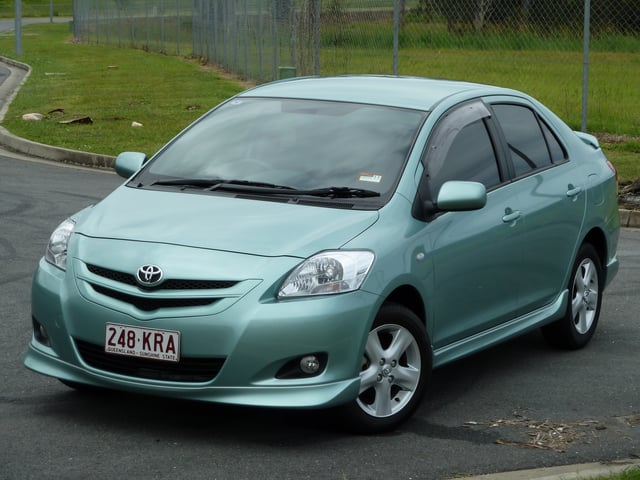
Toyota Yaris YRX (NCP93R) in Australia
In Australia, it is known as the Yaris sedan and is sold alongside the Vitz-based Yaris hatchback.[14] The Yaris sedan is available only in a 1.5-liter 1NZ-FE 81-kilowatt (109 hp) petrol engine. There were two variants of the model, namely the YRS and YRX, with the former being the model with the basic necessities. The YRX model features an all round bodykit and only comes with an automatic transmission.
The Australian version of the Yaris sedan uses orange blinker bulbs with clear lenses instead of orange blinker lenses.
At the end of mid-year 2015, the Australian version Yaris sedan was discontinued due to slowing sales, over 27 percent was during sold. [15] Then the Yaris sedan was phased out with no direct replacement (except the Asian made Vios third generation where its rebadging second-generation is unavailable).
Japan
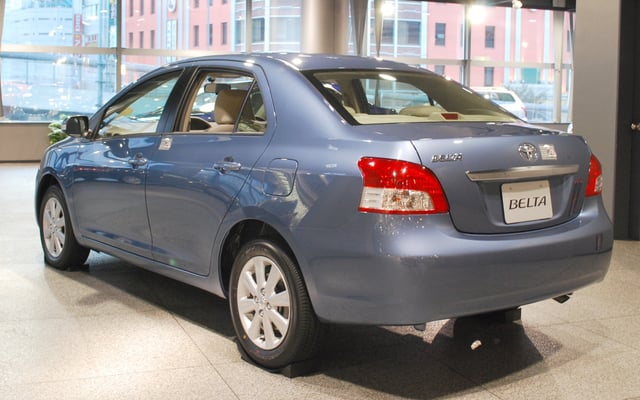
2008 Toyota Belta in Japan
The Yaris sedan is known as the Belta in Japan and its hatchback twin is called the Vitz. There were three engine variants available, namely the 53 kW (71 hp) 1.0-liter 1KR-FE straight-three engine and two variants of the 1.3-liter 2NZ-FE/2SZ-FE engine rated at 63 kilowatts (84 hp). The 2SZ-FE engine comes with Super CVT-i transmission while the 2NZ-FE engine has a Super ECT transmission. An optional S Package is also available across the three variants.
Discontinuation
The Japanese Belta was discontinued in June 2012, replaced by the narrow-body E160 Corolla in the Japanese market; however, the Yaris sedan was still in production for Mexico and Australia until it was discontinued in both countries in 2016. For the U.S. market, the Yaris sedan was briefly replaced by the Scion iA which was called the Yaris iA for 2017 model year. Two years later, the Yaris iA was renamed again to Yaris sedan.
For the Asian market, the XP150 Vios was launched in 2013 as the sedan counterpart to the XP150 Yaris hatchback.

